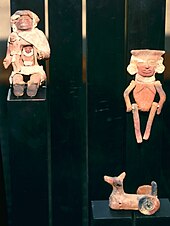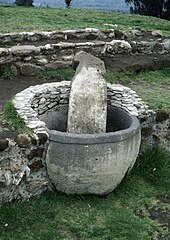Xochitécatl
Xochitécatl is an important archaeological zone in the south of the Mexican state of Tlaxcala . The name from the Náhuatl consists of xōchitl (flower) and the suffix -tēcatl , which denotes the inhabitant of a place whose name ends in -tlān (bei) and means: "He lives near the flower place". The name apparently also refers to the ethnic group of the Xochiteca, which is related to the Olmeca-Xicallanca .
location
Xochitécatl is located near San Miguel Xochitecatitla in the municipality of Municipio Natívitas located at an altitude of about 2300 m , about 24 km (driving distance) southwest of the city of Tlaxcala and about 35 km northwest of Puebla , the capital of the neighboring state. The archaeological site of Cacaxtla is only about 2 km to the east.
Research history
The first excavations took place in the 1970s as part of an interdisciplinary German-Mexican research project by Bodo Spranz . In the 1990s, work continued on a large scale under the direction of Mari Carmen Serra Puche with large-scale restorations.
The location
The site is on an extinct volcano around 100 m above the valley surface of the Río Atoyac. The surface of the mountain has been artificially changed in ancient times to create space for large structures on a platform. These are mainly pyramid-like constructions on three sides of a central plaza. In the east is the largest, the flower pyramid (Pirámide de las Flores), in the south the snake pyramid (Pirámide de la Serpiente), in the west the spiral pyramid (La Espiral). In the middle of the plaza in front of the flower pyramid is the low platform of the volcanoes (Basamento de los Volcanes). Of course, all of these names are inventions of archaeologists.
The center is originally from the Middle Preclassic (800 BC) and was first abandoned around 100. Another settlement is likely to have begun around 650 during the Epiclassical period, at the same time as the Cacaxtla on the next hill . During this time the flower pyramid was brought into its current shape and the small platform of the volcanoes was erected in front of it. Like Cacaxtla, Xochitécatl was abandoned between 900 and 1100. One reason could have been the high activity of the Popocatépetl . The housing estate of Xochitécatl was located around this district on the terraced slopes of the mountain and also dates back to the Middle or Late Preclassic.
The amazing objects of Xochitécatl include several large monolithic stone basins (up to 2.5 m in diameter), as they are known from other simultaneous sites in the wider area. They were found at the foot of the stairs to the flower pyramid. Sometimes there were other stone monuments in the basin.
Also noteworthy are the figurines that mostly come from the platform of the volcanoes. Several show pregnant women with a square opening in the abdomen through which the unborn child can be seen (and removed).
Flower pyramid
In terms of volume (120 × 165 m) and height (over 30 m), this is the largest pyramid of the Xochitécatl. The construction consists of eight sloping steps. The uppermost platform is reached by a staircase, on which more than 2000 clay figurines of women in all phases of life (including pregnant women with a window in the stomach) were found during the excavations. They usually show lavish clothing with various patterns. More than 30 children's graves were found inside the construction. Greenstone pearls lay in the mouths of some of the children. The building comes from the Middle Pre-Classical period and has been changed and expanded again and again.
Snake pyramid
This building also comes from the Middle Preclassic and was originally rectangular in shape. The name comes from a monolithic stone basin in which a damaged stele lay. The forked tongue and teeth of a snake can be seen on the stele. The ascent was via a ramp, and later via a staircase made of Tepetate blocks. Tepetate is a hardened form of volcanic ash.
Spiral pyramid
This building with a circular floor plan consists of nine sloping steps arranged in a spiral. They also form the only ancient access to the platform at the top of the pyramid. The pre-classical building was built over several times without changing its character.
See also
Individual evidence
- ^ Hanns J. Prem : History of ancient America . Oldenbourg, Munich 2008. ISBN 978-3-486-53032-2 . P. 180
- ^ Municipio Natívitas - Places in the municipality
- ↑ Bodo Spranz: The pyramids from Cerro Xochitecatl, Tlaxcala, Mexico . The Mexico Project of the German Research Foundation, Vol. 12. Steiner, Wiesbaden 1978
literature
- Mari Carmen Serra Puche: Xochitecatl . In: The Oxford Encyclopedia of Mesoamerican Cultures . Oxford University Press, Oxford. ISBN 0-19-510815-9 . Vol. 3 pp. 357-358
- Mari Carmen Serra Puche: Recorrido por Xochitécatl . In: Arqueología Mexicana 56 (2002) 75-76.
Coordinates: 19 ° 14 ′ 42 " N , 98 ° 20 ′ 58" W.



